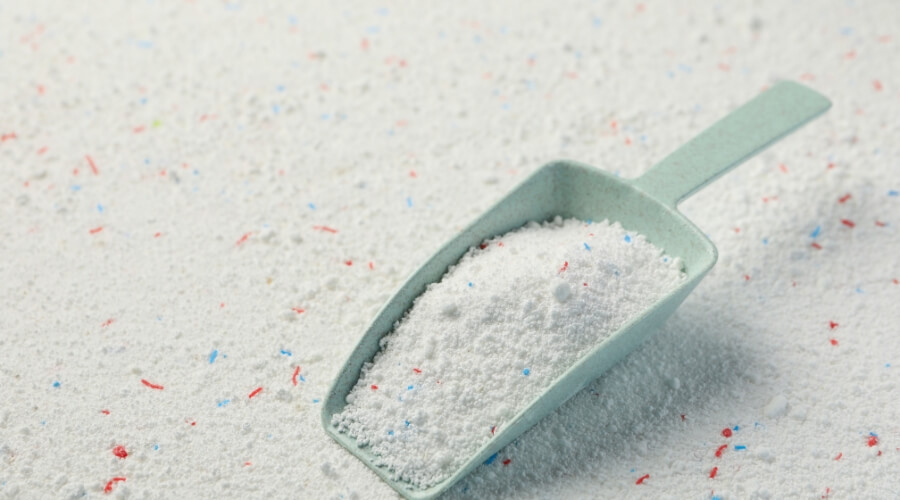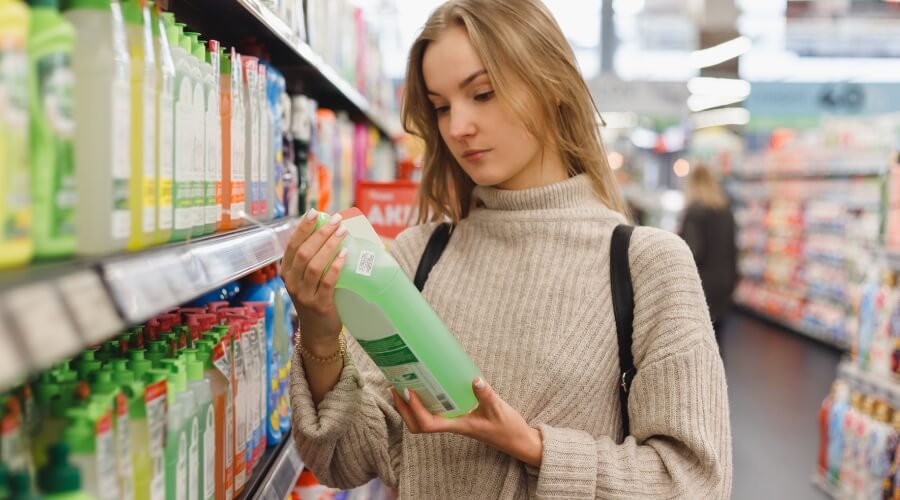Laundry detergent used by consumers attempts to thread the needle. It must be powerful enough to get clothes clean and remove most bacteria, while not being toxic.
With toxic laundry detergent, sometimes it comes down to the mix of ingredients included, such as dyes, sulfates, and bleaching agents. Other times, the parts per million (ppm) level is the critical factor.
In this article, I consider what is the most toxic laundry detergent, how to stay safer, and other aspects to be aware of.
The Danger and Health Concerns of Toxic Laundry Detergent
Detergent isn’t a new type of product. It’s been essential in the home since the days of hand washing clothes before automatic washing machines became affordable.
Detergents Have Improved Over the Decades
Initially, ingredients and byproducts from the manufacture of detergent (and other household cleaning products) were what worked. Occasionally, the cheapest options were adopted, even if not the safest ones.
Byproducts originating from the detergent production process exist, too. These do not show on product ingredient lists, making it difficult for consumers to shop sensibly on behalf of their families.
Over the decades, as scientific knowledge improved about the potential dangers of various ingredients, detergent manufacturers adjusted their formulations.
Also, the highly litigious nature of American business was a telling factor; companies wished to avoid lawsuits alleging potential harm caused by their products.
How Detergent Gets into the Human Body
Not all detergent ingredients come out in the wash. The detergent gets into the water, cleans the laundry load, and is supposed to be rinsed away. Sometimes, this isn’t the case.
Detergent, either when added to the detergent drawer or clinging to the washed items, gets into our bodies. It arrives via airborne contaminants, skin exposure, or gets on our hands and into our eyes when rubbing them.
After a wash cycle, even flushed water through the drainage system is a concern for water recycling, reuse, and marine life.
Known Risks Associated with Ingested Toxic Laundry Detergents
Depending on the chemicals present, they’ve caused respiratory issues for sensitive people, such as those having asthma or COPD. Organ damage and disease, including liver and kidney issues, are possible. In the worst case, cancer.

8 Laundry Detergent Ingredients to Avoid
Here are the 8 laundry detergent ingredients to run away from! If you see these in the ingredient list, purchase a different laundry detergent.
Sodium Laureth Sulfate or Sodium Lauryl Sulfate
Sometimes shortened to SLES and SLS, respectively, these two are chemical ingredients believed to be carcinogenic for humans and dangerous for marine life.
Wastewater runoff is one concern here.
Nonylphenol Ethoxylate
As a surfactant, it reduces the clinginess within water, which aids in dirt removal. It also adds foam to the H2O.
However, it’s bad for the human reproductive system and damaging for marine life, too.
Color Dyes
Color dyes change how detergents appear to the naked eye. Dye-free options are better because they’re less likely to irritate the skin when wearing laundered clothes.
Natural ingredients used to produce color dyes are an acceptable alternative, too.
Phosphates
As a mineral, detergent brands add phosphate to numerous household cleaners.
It is a cause of eye and skin irritation, so any detergent getting into these extremities is an issue. Wastewater from a washing machine with phosphates risks exposure to others.
1,4-Dioxane, aka Dioxane
A byproduct of manufacturing, 1,4-Dioxane is a suspected carcinogen. It’s not directly found on ingredient lists. However, it is contained in various polysorbate ingredients, sodium laureth sulfate, polyethylene, and more.
California State lists it as a potential human carcinogen, and New York State limits its inclusion in detergents.
Brighteners (Optical)
An optical brightener makes clothes whiter and colored clothes vibrant.
Unfortunately, it contains a host of chemicals, such as benzene. Several of these chemicals have the potential to cause cancer or introduce reproductive issues in humans.
Bleach (Chlorine)
Public pools often contain chlorine. If you notice that you’re itchy after taking a dip in a pool, then you’re sensitive to it.
Not only is this bad for your skin, but marine life also suffers when exposed to it.
Formaldehyde
As a preservative, Formaldehyde is found in laundry and other cleaning products due to its disinfecting, shelf life-extending properties.
However, at low levels, skin exposure is bad. At higher levels, it introduces a cancer risk.
In detergents and household cleaners, it’s spotted on the label by looking for Quaternium-15, DMDM hydantoin, imidazolidinyl urea, or Dioazolidinyl urea.
What is the Most Toxic Laundry Detergent?
The Environmental Working Group encourages making healthy choices through better product selection. They rate detergents from A (safest) to F (least safe) for consumer use.
Also, bear in mind that their ratings reflect specific detergent-branded products, not their entire range of products within that group.
Therefore, even within the same cleaning detergent brand, the hypothetical “Lemon Crisp” aroma product version may rate highly whereas their hypothetical “Spring Morning” version may not.
Here are some of the most toxic laundry detergents (F-rated) based on current ratings:
- Arm & Hammer (Plus OxiClean)
- Ajax (2X Ultra, Original)
- Babyganics (Fragrance Free, 3x)
- Fab Ultra (Spring Magic)
- Gain
- Ivory (Ultra-Snow)
- Persil (Sensitive Skin, Porcelain Power)
- Safeway Ultra (Pacs, Free & Clear)
- Tide (Plus Bleach Alternative, Original)
- Up & Up (Lavender)
- Wisk (High-Efficiency)
- Woolite Everyday (Sparkling Falls)
- Ultra Purex (Original Fresh)
Safe Laundry Detergent
Following the most toxic detergents, EWG also provides their A-rating for the most recommended detergents based on their analysis.
Here are some of the safer detergents from their list:
- Earthley (Unscented)
- Hello Bello (Unscented, Organic)
- Common Good (Unscented)
- Greenshield (Free & Clear)
- Martha Stewart Clean
- Meliora (Powder, Unscented)
- Bronner’s (Unscented, Baby)
- Dropps Active (Unscented, Pods)
- Molly’s Suds, Laundry Detergent without the risk
- Ingredients Matter (Fragrance-Free)
- PUR Home (Free & Clear)
- Seventh Generation (Tablets, Fragrance Free)
- Whole Foods Market (Unscented, Baby)

When Shopping for Laundry Detergent
Consumers are often baffled by what to look for in laundry detergent. And that’s completely understandable.
Screen for Bad Ingredients
Take on the responsibility of looking at the ingredients in the box or bottle before purchasing.
See our list of toxic detergent ingredients, two sections above, for those to avoid or limit exposure to.
Avoid or Limit Common Toxic Ingredients
Avoiding 1,4-dioxane (sometimes referred to simply as dioxane) isn’t a bad idea.
As we cover in the next section, it’s now limited to a low 2 parts per million in laundry detergents sold in New York. Other States may follow suit or limit other ingredients or byproducts.
With 1,4-dioxane, also consider that it’s present in other ingredients, too. So, if found in your detergent, then 1,4-dioxane likely is lurking there too. These include sodium laurate sulfate, polyethylene glycol aka PEG, and polysorbates.
Organic / Natural / Environmentally Friendly Detergents
Look for detergents marketed as organic, natural, or environmentally friendly. However, take the brand messaging with a grain of salt.
Delve into the ingredients to discover what’s there and not present. Search for consumer reviews from professional sources that examine the chemical composition in a lab.
Environmental Working Group’s Guide to Healthy Cleaning
The Environmental Working Group rates several thousand household cleaning products. This is part of EWG’s Guide to Healthy Cleaning.
To narrow your search, their ratings are conveniently divided into different locations in the home. This allows consumers to discover safer cleaning products for many purposes.
As we covered earlier in this article, their A-rated detergent list allows you to create a personalized list of high-quality detergent products. Narrow the list by affordability to safely do your laundry without breaking the bank.
Laundry Detergent Banned? What Have I Heard?
Like many things in life, moderation is a safe bet. Excess, anything beyond a reasonable level of consumption or exposure, is a slippery slope. The same is true with some ingredients and byproducts of laundry detergents.
1,4-dioxane (EPA PDF file) is one such issue. I did not find it in detergent ingredient lists because it’s a byproduct of the production process.
The parts per million (PPM) measurement is where moderation versus excess comes into play. Some legislation, and rules by the Environmental Protection Agency, or at the State level, set limits or outright ban products with certain ingredients, byproducts, or contaminants.
In a recent case, New York State updated its Environmental Conservation Law to set a hard maximum limit of 2 PPM for 1,4-dioxane. No cleaning products, including laundry detergent, are now allowed on supermarket shelves, and sold elsewhere in NY, if they contain higher levels.
Major consumer detergent brands like Gain, Arm & Hammer, and Tide exceeded the PPM limit.
The affected brands need to:
- Create new formulations for existing products to meet the revised NY environmental laws.
- Pull their products off the shelves.
- Release new detergent products meeting these requirements.
To Wrap Up
Avoiding unsafe laundry detergent requires a little foresight and smart shopping. When using our list of safe laundry detergents or the EWG’s guide, it’s possible to make good choices.

